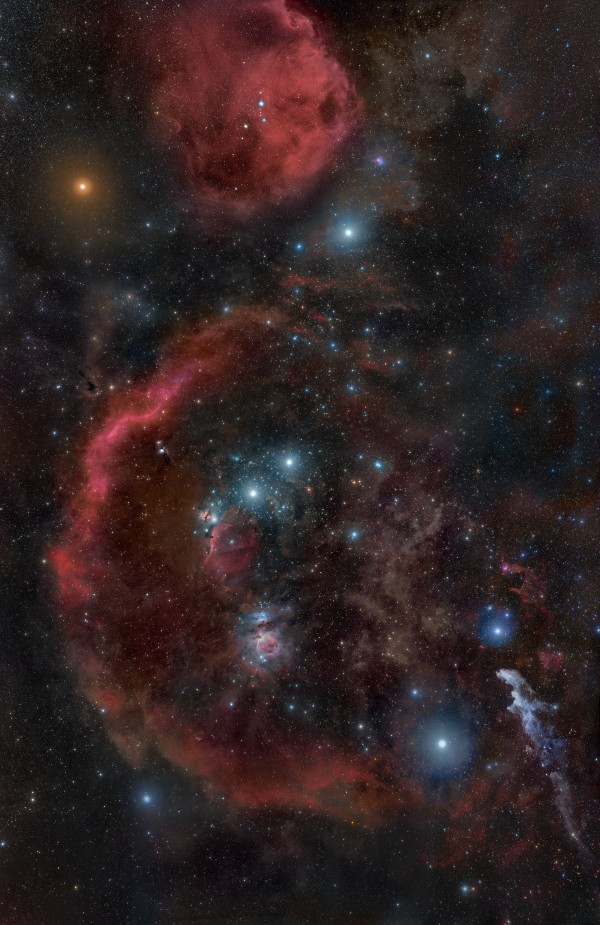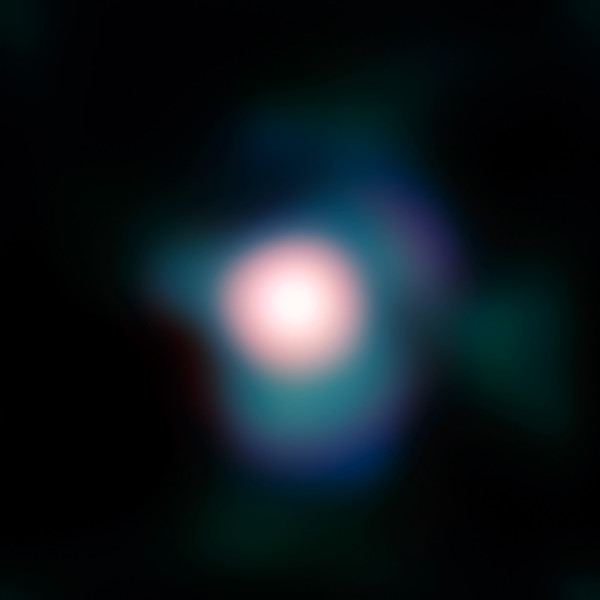One of the great, catastrophic truths of the Universe is that everything has an expiration date. And this includes every single point of light in the entire sky.
 Image credit: Rogelio Bernal Andreo of Deep Sky Colors, via http://deepskycolors.com/astro/JPEG/RBA_Orion_HeadToToes.jpg.
Image credit: Rogelio Bernal Andreo of Deep Sky Colors, via http://deepskycolors.com/astro/JPEG/RBA_Orion_HeadToToes.jpg.
The most massive stars -- like Betelgeuse (at the upper left) -- will die in a spectacular supernova explosion when their final stage of core fuel runs out. At only an estimated 600 light years distant, Betelgeuse is one (along with Antares) of the closest red supergiants to us, and it's estimated to have only perhaps 100,000 years until it reaches the end of its life.
When that happens, what are we in for?
 Image credit: ESO/P. Kervella, of Betelgeuse as seen today, at the highest resolution ever observed. Via http://www.eso.org/public/images/eso0927b/.
Image credit: ESO/P. Kervella, of Betelgeuse as seen today, at the highest resolution ever observed. Via http://www.eso.org/public/images/eso0927b/.
More like this
“Without these supernova explosions, there are no mist-covered swamps, computer chips, trilobites, Mozart or the tears of a little girl. Without exploding stars, perhaps there could be a heaven, but there is certainly no Earth.” -Clifford A. Pickover
"We should do astronomy because it is beautiful and because it is fun. We should do it because people want to know. We want to know our place in the universe and how things happen." -John Bahcall
Artists can color the sky red because they know it's blue. Those of us who aren't artists must color things the way they really are or people might think we're stupid.
-Jules Feiffer
Those sneaky rascals at the Templeton Foundation have asked one of those ridiculous questions that gets some otherwise rational people stumbling over themselves to give an inoffensive answer: does the universe have a purpose?

"makes up the left hand shoulder of the warrior"
We've been staring at his behind for all these millennia?
I was just thinking about novas and supernovas last night as I walked home. I saw a 'star' in the sky so much brighter than the others that I literally stood there for a few seconds wondering if it was going to go boom. I assume it was really Venus (approx. 9pm US East Coast, if anyone wants to enlighten me).
I think chemistry's 'negative enthalpy = heat produced' is right up there. Thermodynamics: needlessly confusing students since 1875!
@1
depends on artists rendition of Orion the hunter.. not warrior, at least in greek mithology he was a hunter. Today, mostly it's imagined standing frontal and holding a bow.
But in some medieval illustrations he's oriented backwards. And in some illustrations he's holding a club, because that's how Homer described him in Odyssey.
I'm not sure what it is about the telescope image of Betelgeuse but the static image of the star in the picture looks like it is shrinking to me. As I try to focus on details, the detail I'm looking at shrinks. The weird optical effect was even more pronounced in the larger pixelated image linked from the article. Am I the only one who sees that?
This discussion raises a question of what would the total radiation dose on earth be from such an event. Recall that supernovas eject gamma rays beta particles etc when they explode.
Lyle, I think the gamma ray burst would come from the poles of the star, which aren't currently aimed at us.
Eric, Venus probably set in the west before 8 PM local time. At 9 PM, Jupiter would be high in the sky toward the east and at magnitude -2, a bit brighter than Sirius which would have been further south.
Some of the questions about harmful radiation from a nearby supernova can be found at
http://stupendous.rit.edu/richmond/answers/snrisks.txt
Short version: Betelgeuse very likely wouldn't hurt a fly.
@Denier
I didn't notice before reading your comment but I see it too. I think the colors make it a weaker version of this
http://walls4joy.com/walls/anime-manga/illusions-optical-illusions-psyc…
The reddish (lyman-alpha) colored semicircle on the left side looks like a supernova remnant -or is it simply a gas cloud scattered by intense ultraviolet radiation?
"Supernovae are incredibly bright phenomena."
Am I the only one whose instinctive reaction to this statement was: [citation needed]?
Yes?
I am curious what color the supernova will appear? White? Red? Will it vary?
While optically thick, it will shine like any sun would if it managed to get the massive temperatures that the supernova would achieve in its outer envelope, so it would be radiating mostly outside (above) the human range, and therefore appear blue-white to us.
Even in its Red Supergiant stage, it will still be as white-ish as a standard lightbulb, artists' impressions notwithstanding.
But after the supernova is over, the remnants will cool and take on various shades as their cool atoms are excited by the UV and higher energy photons from the remaining main body, just as can be seen with the Crab Nebula.